popular in recent times, a beautiful and affordable way of decor - textured paint.
In terms of composition, this is a coarsely dispersed mass, which includes acrylic and various mineral additives - scaly, drop-shaped, etc. Due to additives, the treated surface is textured. The paint is applied with a spatula, roller, brush, using a pneumatic sprayer. Depending on the source material and the method of staining, the final appearance of the surface and the consumption of paint differ.
The advantages of the method include:
- surface treatment speed;
- a variety of final decor options;
- Using textured paint, it is easy to mask minor wall defects.
There are also disadvantages: consumption (up to 30% more than conventional paint coating). If you want to change the decor, you will have to completely clean off the previous paint, otherwise you will not be able to achieve a beautiful textured layer.
Applying textured paint
It is better to put the first layer with a spatula, but it is better to use it if the paint is very thick and embossed, and the filler is rough. The final texture of the surface will depend on whether the trowel is hard or soft. You need to apply paint in single strokes, it is better to determine the directions in advance. You can create interesting relief options.
If you are going paint with a brush, it is better to take a wide one. The surface must be prepared (cleaned, plastered, primed). Apply paint in wide strokes - first in a horizontal, then in a vertical direction (or vice versa). You can draw patterns with a brush.
For roller painting it is desirable to acquire three rollers for textured paint at once: two are identical, one is smaller. The paint is applied with vertical movements with a large roller, irregularities are corrected with a small one. Excess paint (excess layer) is removed with a clean roller.








You can buy paint directly from the sprayer. Before applying it to the wall, it is better to test it on a small surface, so you will find out which layer to spray and in which direction it is better to do it.
Tip: there is an option to apply paint in another, not quite traditional way - with a sponge. The depth of the relief, its texture will depend on how granular the sponge you have chosen. You can "draw" with a sponge using a stencil.
Finally, you can prepare textured paint with your own hands. To do this, you buy regular acrylic in the color you need and mix it with filler. The filler is also sold - for example, granite crystals, sifted sand, etc.
Options - combined surface: a combination of ordinary paint with separate textured inserts. Or a combination of textured areas painted in various ways - for example, the main surface is sprayed, and individual fragments are painted with a sponge on a stencil or brush.
The process of working with this material is not complicated, but it differs somewhat from the technology of applying conventional paint. Before proceeding with the use of textured paint, we recall the competent pre-treatment of the surface.
Wall preparation
Textured paint is applied in a thicker layer compared to conventional paint, therefore, the requirements for surface strength are also increased. It should be dry (no more than 2% humidity), not dusty, without foreign deposits.
All areas that impair adhesion, such as old cracked, crumbling layers of finishes, whitewash and other paint surfaces, should be removed. If the base coat is oil paint, the wall should be examined for peeling and swelling. Where the paint is well preserved, its surface must be sanded: for better adhesion, it should become matte.
If, after removing the base coat, you have an ugly wall with rough drops, it should be lightly puttied to even out the irregularities at least to a level of 2 mm. Large cracks are recommended to be reinforced with mesh.
The finished surface must be clean, dry, not "chalky" and without signs of mold.
Tools you will need:
- Drill with mixing attachment.
- Spatula or trowel.
- Rollers to choose from: smooth, rubber textured, foam rubber, porous.
- Decorative brushes.
- The brush is flat.
- Masking tape.
Wall putty
The quality of the study should be set, however, according to the situation: depending on the desired relief, the paint is selected and the thickness of its layer is set. The thinner it is, the more carefully the surface should be prepared.
Wall primer
Its purpose is to improve the adhesion between the wall and the paint. Refer to acrylic based materials such as Galamix-53 and Galamix-51 or Universal. If the coating crumbles easily, you can use the special strengthening primer "Profi" or apply 2 layers of the usual mixture. Areas affected by mold and fungus are pre-dried and treated with an antifungal primer, for example, Akkurat 115.
After drying, the primer creates a thin film on the surface, filling and leveling the pores at the base of the wall, which facilitates the application of the finish coat, increases its durability and saves on material.
Depending on the manufacturer, temperature and humidity in the room, the primer dries for about 6 hours, after which you can proceed to the finishing stage.
Painting walls with textured paint
Before use, mix the textured paint thoroughly, diluting it, if necessary, with water. Part of the water should be no more than 5-10% of the total mass, otherwise the beauty will become fluid and will not hold its shape. The paint is mixed manually or with a drill with a mixing attachment at low speed for no more than 2 minutes.
Note: material consumption depends on the manner of work, the chosen tool, the degree of preparation of the wall. To get an idea of the consumption, make a test area on the work surface.
How to apply texture paint:
- The first step is to define clear structural boundaries for the top, bottom and trim width using masking tape. Also pay attention to the protection of surfaces that are not to be decorated.
- Lighting is an important factor in the success of the work. It should be sufficient and as close as possible to future permanent lighting in terms of intensity and angle of incidence. The fact is that the relief of the paint is “read” precisely due to the direction of the light, and the right lighting will help create the desired effect on the wall. Both daylight and electric light should be considered.
- If during work you make technological breaks, containers with paint at this moment should be tightly closed.
- The paint is applied with a spatula, roller or spray. If you use a roller, then it should be smooth or with a hard short pile up to 1 cm long. The spray nozzle should be at least 3 mm in diameter. It is recommended to keep the roller in the same direction during the entire application stage in order to form a consistent relief.
- If you use a spatula, then the pattern will be applied in the next step, and not simultaneously, as is the case with a roller. A sufficiently large amount of the mixture is applied to the spatula, which is applied with a layer of 3 mm, and then, within an hour and a half, you have the opportunity to experiment with the texture, correct and add, change rollers and other tools for creating relief.
- It is correct to start work from the corner of the plane to the opposite corner.
- If necessary, painting with textured paint is carried out in two layers, while the second layer should be applied after the first has completely dried, that is, after 3-10 hours.
- To avoid the formation of joints, work within the same plane should occur in one approach according to the “wet on wet” principle.
- After work, the tool must be rinsed immediately with water.
- The time for complete drying of the paint under normal conditions is 24 hours. It acquires final hardness and uniform polymerization only after 14 days.
Remember: the pattern and the resulting texture depend on the material of the roller and the speed of its movement along the wall.
Getting a drawing
Method 1. Textured paint is applied to the wall, as in the photo, using a trowel or spatula with a layer of 2-3 mm. Then the surface is treated with the selected texture roller, by rolling it from the bottom up.
Method 2. The paint is applied in the same way as the first one, an adhesive spatula is taken with teeth and a relief is given with wave-like movements. You can describe semicircles, waves, layer them and change direction.
Method 3. Relief "Bark beetle". Texture paint is applied in a thin layer of 1 mm using a wide spatula. Then, pressing it tightly against the wall, the excess mixture is removed, as a result of which the large components of the fractions leave a path behind them.
Method 4. The wall is pre-painted with paint to match the texture, or, conversely, with a contrasting color. In this case, when scratching, the bottom layer will show through. For example, lilac texture paint is applied to a yellow base. It is also worth experimenting with shades of the same color: light gray and darker, powdery and rich beige.
You can additionally decorate the finished textured wall by mixing an ordinary transparent varnish with a special creative paste. With the help of this technique, it will be possible to notice how the shade of the wall changes from a change in the angle and intensity of lighting.
Technical features of the paint:
- It is forbidden to mix anything and add it yourself to the paint.
- Do not apply the material to the facade in particularly hot or rainy weather, or under direct sunlight.
- During street work, it is necessary to check the serviceability of storm and drainage structures.
- Condensation must not form on the work surface.
- The ambient temperature must be between +5°C and +30°C.
- At internal works ah, good ventilation should be ensured.
Tip: when painting the facade, it is better to choose pastel shades of texture paint: firstly, it is in harmony with the environment, and secondly, any bright color fades from prolonged exposure to light.
Prepare exactly the amount of material that is guaranteed to be enough for one layer. If you have more than one container, make sure that the color of the mixture is the same in all of them. Applying textured paint is a crucial step: use the tutorial videos and consult with those who already have experience in this.
__________________________________________________
Textured paint, according to interior decorators, is an excellent choice for quality and price. It is a special material resembling a homogeneous viscous mass white color. If acrylic is introduced into the composition of such a paint as a binder, the resistance of the textured paint to changes in humidity and mechanical deformations is significantly increased.
Adding a variety of colors to the composition leads to the desired colors, makes it possible to obtain the desired shades.
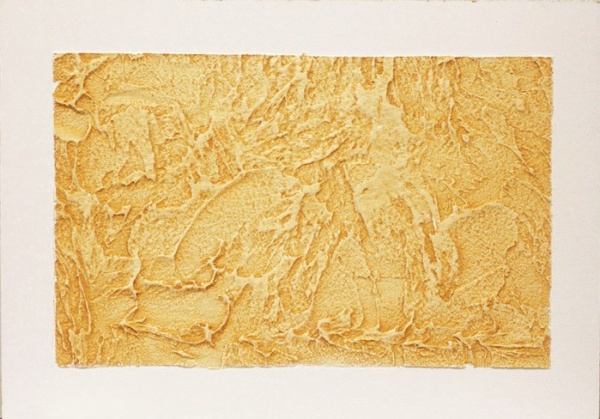
Advice ! You can order a specific shade from manufacturers facade paint receiving quality assurance.
Textured paint can be used to decorate any surface, even with minor defects, their depth should not exceed 2 mm. Depending on the method of applying the paint, it is possible to restore the aesthetic appearance of the surface. This paint has a dense texture, which is why it can be used to get rid of defects.
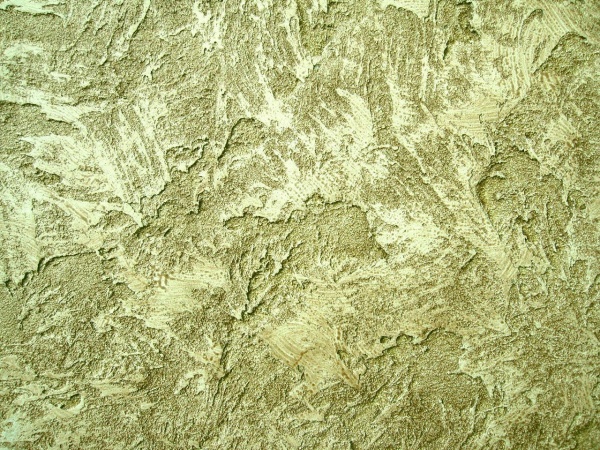
The main advantages of textured materials
This coating in terms of practicality is ahead of the wallpaper and Wall panels. Textured paint is not afraid of high humidity, mold. Care of the finished coating can be carried out with a soap solution. The paint can be applied to any type of surface, including brick, concrete, wood. In addition to acrylic components in textured mixtures, there are also special mineral additives - emulsions.
The main advantages of textured compositions:
- resistance to the negative effects of ultraviolet radiation;
- excellent decorative properties;
- good vapor permeability
It should also be mentioned that this decorative coating does not absorb foreign odors, does not contain harmful substances, and easily withstands temperature changes.
The variety of technical properties of these paints indicates that they are ideal for facade work, interior decoration premises.
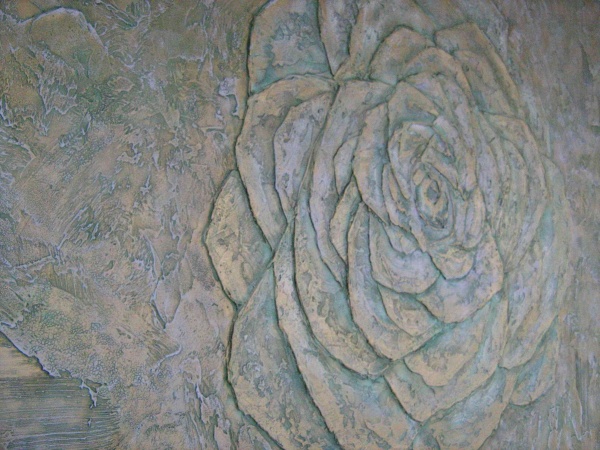
Application methods
The use of facade mixtures in modern design gives you a chance to show all your imagination, create indoors unique option interior. Texture paints make it possible to imitate natural marble, fabric, floral ornaments. To implement the plan, you need to master the technology of applying a textured composition, use special tools and materials.
The relief surface of the wall can be made using sawdust as a filler. To create a smooth texture, ordinary water is required.
Sharp edges can be obtained using quartz sand as a filler.
For full-fledged work with textured paints, you will need certain tools:
- putty knife;
- brushes;
- natural sponge;
- rollers of various sizes and shapes
Using a brush, after the material hardens, you can make fancy pictures on the wall.
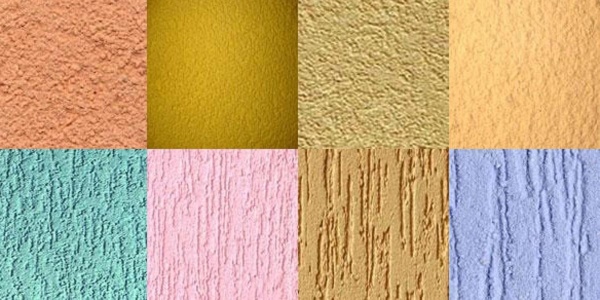
Attention ! When creating a uniform wall structure, it must first be applied horizontal stripes, then vertical. When choosing a roller, keep in mind that you will need several rollers at once, differing in width.
The paint base is applied with a wide roller, performing vertical movements. To eliminate inaccuracies, work in hard-to-reach places, use a small roller.
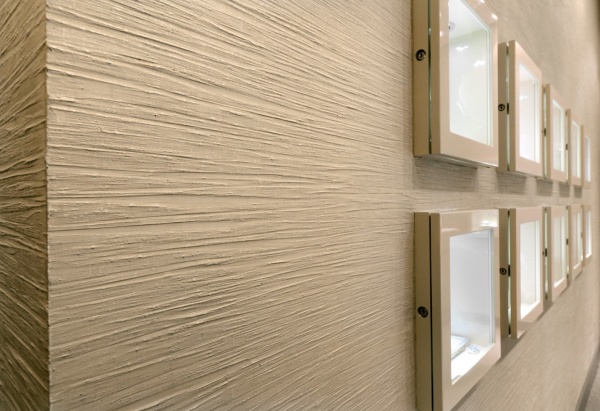
If you wind a rope around the roller, the up and down movements can imitate the stems of plants on the wall. If desired, you can purchase special rollers on which a certain pattern is applied. A spatula will help you make unusual stains on the wall. For paint that contains a coarse filler, a coarse spatula is suitable. Use a soft spatula to create delicate textures. To obtain unique patterns, you can use ready-made stencils. A two-color pattern on the wall can be done using the following method:
- Apply base paint to the wall. Until it is completely frozen, make horizontal stripes with a sharp object.
- Apply a solution of the second color, armed with a stencil.
As a result, you will get a drawing, the effect of which will be added by a relief surface.
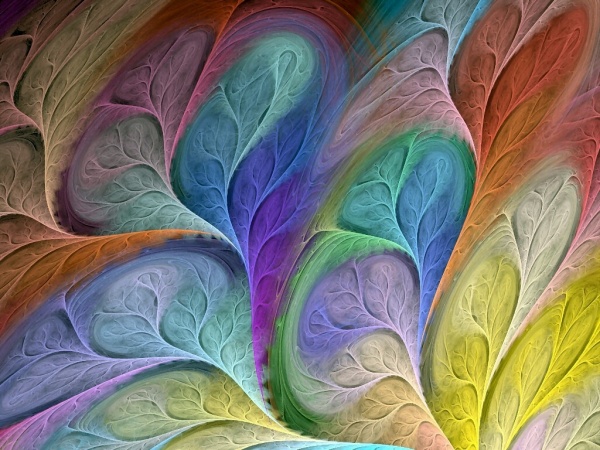
If you arm yourself with masking tape, you can make a fancy geometric pattern on the wall. The tape must be glued to the wall, making a certain geometric pattern. Next, a textured paint of a different color is applied to the wall. After drying, the tape is removed, enjoy the result.
If you run a comb with large teeth along a wall painted with two colors, you can unusually “comb” the wall.
Advice ! To achieve the desired effect, do not wait for the top coat to dry completely.
How to prepare the walls
Full-fledged painting with textured paint walls involves their preliminary preparation. You need to get rid of the old coating, remove dust and dirt from the walls. In the presence of cracks, cracks, they are puttied. Next, a layer of finishing primer is applied to the wall. It is needed to ensure high-quality adhesion of the material to the base of the wall. The primer should eliminate all the irregularities on the surface, it will give the patterns expressiveness and originality.
Moisten the wall with a damp cloth, apply a thin layer of primer on it. After 4-24 hours (drying time of the primer), you can perform a decorative wall finish. Working with textured paints is different from applying conventional paints to the surface. First, the paint is heated to 20 degrees, in the case of a thick consistency, water is added to it. Time of full drying of paint - 24 hours.
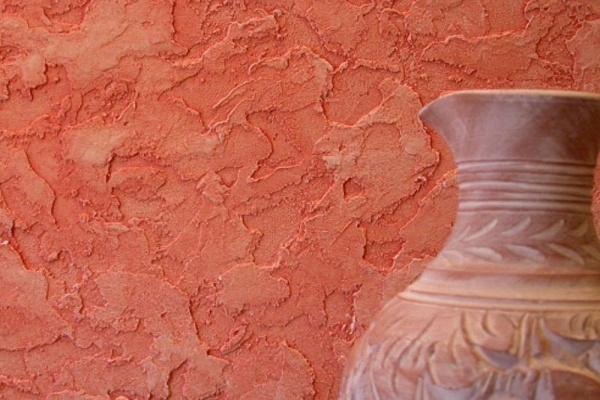
Varieties of textured wall paints
With the help of such coatings, the following surface options can be obtained:
- Misuri. Acrylic starch is added to the mixture.
- Relief. Sawdust or crumbs are introduced into the mixture as fillers.
- Marseille wax. You will get a wonderful imitation of old stone, bark. To consolidate the result, an additional glazing paint is applied to the wall.
Common manufacturers of textured paints
amour color. With the help of such compositions, you can make a unique interior. Materials have high wear resistance, excellent quality. Manufacturers offer three product options: Perlata, Tactite, Escenta.
Perlata is based on water and is considered an environmentally friendly material. The paint includes pigments that are similar to pearls, adding an element of luxury to the interior.
Escenta is full of undertones that captivate the eye.
Tactite is unique in that it gives the surface a resemblance to a marble mosaic.
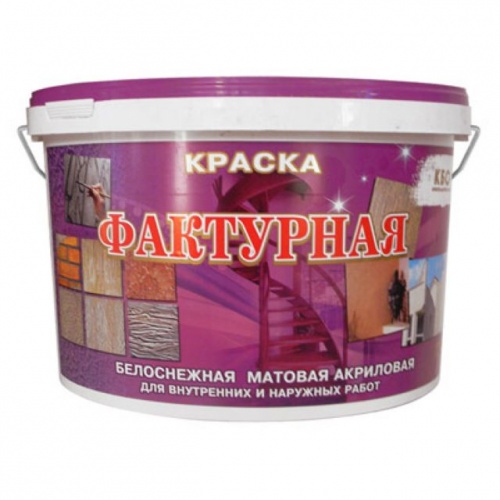
Paritet Decor. The company specializes in the manufacture of fakurnyh materials High Quality. The range of products offered is wide, we will present you some paint options:
Matiere imitates natural wood, expensive fabric. Such compositions are suitable for any environment, introducing an element of luxury into it.
Marrakech combines ancient technique and modern materials, brings harmony and peace to the room. This decorative coating fits perfectly into the Moroccan style, reminiscent of the interiors from the book "A Thousand and One Nights".
Les Perles presents blends that contain a special pigment - mother of pearl. Purity, elegance, color transitions suggest waves, clouds.
Craquelee is an antique canvas finish. This mixture can be used to decorate walls in the old style.
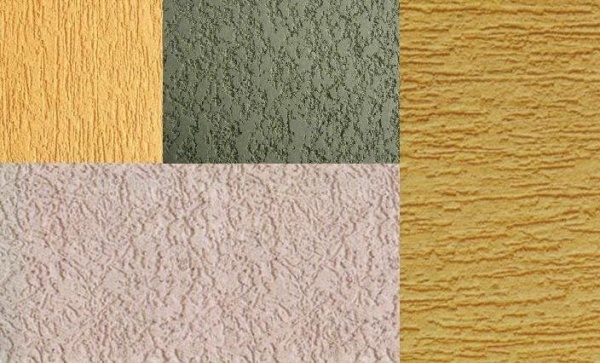
Painting the walls in the bathroom
To update the bathroom, textured vgt paint is suitable. First you need to make sure that the wall is not subjected to vibration, check its strength. Further, dust, dirt are removed from the walls, all flaws are eliminated with the help of puttying.
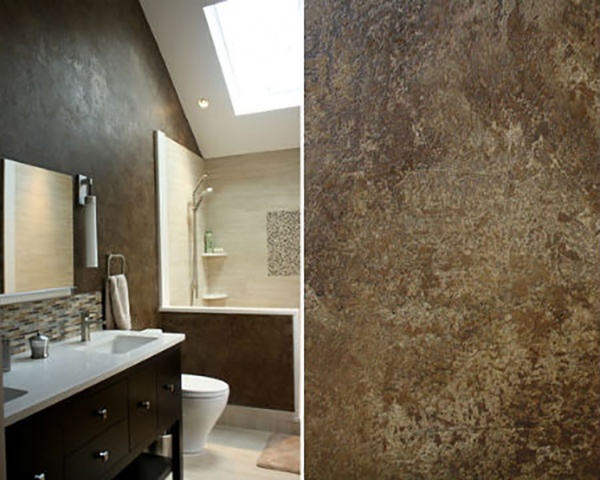
We propose to act according to the following algorithm:
- If the composition is applied with a spatula, then its size should not exceed 15 cm. The best option would be asymmetrical application of strokes.
- Using a stencil is appropriate when creating three-dimensional images. It will take 2-3 hours for each new layer to dry.
decorative paint for walls: instructions, photos, videos, technologies and recommendations. From this article you can learn about all the features that textured wall paint used in modern interiors: properties of the finishing material, its advantages and disadvantages, varieties, popular effects that can be created using a coloring composition, prices. The process of preparing the walls and the detailed technology for applying textured paint, including photo and video materials, will be considered.
Using textured paint, you can achieve both a perfectly flat surface and give the wall a unique decorative look.
Textured wall paint as a finishing material
Textured or texture paint for walls can be attributed to one of the varieties decorative finishes, thanks to which you can create beautiful relief patterns on the treated surfaces. This became possible due to the special composition and density of the material. The coloring composition may have a creamy consistency, or be a thick viscous mass made using acrylic components.
To some extent, textured paint can replace paintwork and finishing plaster. In this case, there is no need to carefully level and plaster the surface. It is enough to putty the walls for painting in areas where there are large cracks and deep holes and then apply an acrylic impregnation coating.
Note! Painting that gives surfaces a textured effect can be used not only as a decorative finish. This material perfectly hides small defects on the walls that ordinary paint or wallpaper cannot mask.
Varieties of decorative paints for walls in apartments
Structural dyes are commercially available in two options:
- Liquid - the compositions are completely ready for use. They already have the necessary shade, so there is no need to use color.
- Dry - the second name of these compounds sounds like decorative plaster. This type of dye is diluted with water, where dye is added to give the desired shade.

Textured paint can give a wall an interesting textured effect.
Acrylic latex used in the production of textured paints undergoes polymerization during evaporation and absorption of water. Due to this, the drying time of the dye is only 1-2 hours. As a result of using the material in its pure form, a finishing layer 0.2-2 mm thick is formed on the surface. If additional components such as sawdust, sand and other materials are added to the dye, the layer thickness can be increased to 0.7-1 cm.
When using additional components, the composition can be used as a plaster to level small damages on the walls (up to 2 mm deep). Due to the fact that the acrylic aqueous solution penetrates deep into the treated surface, which can be made of concrete, brick and covered with plaster, the adhesive properties of such paint can be compared with the capabilities of most cement mortars.
After the polymerization process is fully completed, the surface of the acrylic material acquires waterproof properties. For this reason, many textured dyes are suitable not only for interior, but also for exterior decoration.

One of the most popular types of textured wall paint is sand effect.
Note! Textured decorative paint for interior wall decoration can be safely used to decorate the design of a bathroom or kitchen, where the level of air humidity is increased. After the composition dries, the surfaces will be reliably protected from mold and moisture.
Types of fillers in structural wall paint
Density and relief is provided by the particles that are included in the composition of the dye. Textured finishing materials are also classified according to the type of fillers, which can be:
- gas silicate in crushed form;
- marble or granite chips;
- metal particles with a reflective surface;
- quartz sand;
- fibers of natural or synthetic origin;
- sawdust.
Also, the composition may contain modified starch as a thickener and special pigments, thanks to which it is possible to obtain wall paint with the effect of silk or mother-of-pearl coating. Most often, such particles are in the form of droplets or flakes.

Some types of paints have additions - sparkles, flakes, pile and other materials, which in the end will be nicely distributed on the wall.
The relief of the dye and the depth of its structure depends on the size of the filler particles:
- Fine-grained dyes - are created on the basis of filler particles with a diameter not exceeding 0.5 mm.
- Medium-grained compositions - include particles with a size of 0.5-1 mm.
- Coarse-grained dyes - the composition contains fractions with a diameter of 1-2 mm.
Before you buy graphite wall paint or another type of dye, you should read the manufacturer's recommendations for use. As a basis for applying the dye, plaster, wood, brick or stone masonry, and a concrete surface can be used.
Disadvantages of interior paints for walls and ceilings
The main distinguishing feature of textured dyes from compositions that form a smooth surface is decorative. With the help of structural paints, amazing effects can be achieved. On sale there are options that mimic different kinds natural surfaces and materials:
- sand;
- wood;
- stone.

Thanks to texture paint, you can add depth and completeness to the room.
Note! Material consumption is about 1 kg/m². Before making a purchase, it is worth calculating the budget in advance, since the total cost of finishing can be very high, because the price of decorative wall paint, especially with unusual effects, is much higher than that of wallpaper or standard dyes.
Despite the fact that painting can be done on top of finishing putty, wood panels, chipboard, glass, plywood, metal and plasterboard (gypsum boards), the base still requires preparation. A qualitative result is possible only if the surface of the base is even and clean. In addition, certain skills may be required to create a creative design. This is where the shortcomings of the finish end.
Advantages of interior paints for walls and ceilings
Advantages of finishing in the form of decorative paint:
- long service life - the average is 10 years, while high-quality wallpapers can last about 5 years;
- the possibility of updating the coating by applying a new layer of paint without the need for prior removal;
- environmental friendliness and safety;

To create special effects when using texture paint, you must use additional tools - a roller, sponge or a special spatula
- resistance to mechanical stress and the influence of sunlight. The surface does not provoke the development of mold;
- the possibility of creating a monolithic coating;
- simple care system due to the washable surface. At the same time, the paint repels dirt well. This advantage is especially relevant for corners and areas around switches;
- choice design solutions, shades and textures will not make the buyer think about how to get an unusual effect. Even the most sophisticated will find suitable options for their home;
- the material gives complete freedom in relation to experiments. You can choose different shades or reliefs. Textured paint is applied in layers using special rollers or spatulas. The choice of tool depends on what effect you want to get;
- the versatility of the paint allows you to use it for decorating the walls of the living room, kitchen, nursery, bathrooms;
- rich appearance;
- unique textured pattern;
- the decorative coating has antistatic properties, due to which dust is repelled from the surface;
- good vapor permeability of the coating, which does not create obstacles for the movement of air masses in the room.
![]()
Some types of texture paints involve several layers of application of different shades and textures.
How to paint walls in an apartment with textured paint: photos of interesting design options
As a result of painting the walls with textured paint, it becomes possible to create an exquisite and unique interior. Each coloring composition has its own graininess. The deeper and more expressive the texture should be, the greater the graininess of the filler should be selected. This indicator is indicated by the manufacturer on the packaging.
Useful advice! Before proceeding with the direct application of paint, it is better to practice on a small section of the wall or on a piece of plywood. If a wall is used as the basis for the test, the layer of coloring composition applied during training must be removed after completion with a steel spatula. Then the surface of the wall should be dried and coated with a primer.
What paint to paint on the walls: the choice of the optimal dye
The most important criterion for choosing a textured wall covering is the base of the dye. Given this parameter, there are several types of finishing materials for creating textures.

In order for the paint to have an attractive appearance for a long time, it is worth taking care of the quality preparation of the wall before painting.
silicone paint- the most common type of dye, intended for outdoor and indoor use. The material allows you to create a vapor-tight coating that is resistant to negative environmental factors (aggressive influence from the outside, moisture, temperature changes).
mineral dye- the cheapest option for finishing in the form of a dry powder. The composition of the material is lime and cement. Most often, the dye is used to finish the exterior walls of the building.
silicate composition- considered the most expensive option while being practical to use. The coating is absolutely not afraid of external influences, it is easy to clean and perfectly repels dust particles and dirt. The material must be used with a primer having a similar base.
acrylic paint- comes ready-made, so it is very convenient to use it. It is allowed to add fillers necessary to create a certain effect, as well as tints to correct the color.

One of the most modern and fashionable trends in the field of design is the use of textured paint with a stone effect.
Standard textures of decorative wall paint: photo examples and composition features
There are several basic textures that can be obtained with texture paint.
Relief texture- the formation of such a coating is carried out due to special fillers in the composition of the dye. The application technology is very simple, so even a person who does not have experience can cope with the work.
mizuri- to create this type of coverage will require a lot of effort. This requires a textured acrylic-based paint with the addition of modified starch. With the help of this composition, you can create not only a textured, but also a flat surface.

The method of applying Atacama textured paint has a bewitching effect - in daylight and evening lighting, the walls look different, while being very pleasant to the touch.
Marseille wax- the finish is refined and stylish, but its creation will require professional knowledge and skills. With the help of the material, you can perform a realistic imitation of cork, tree bark or aged stone. To get a deep rich color, the finish is covered with a special decorative wax. The material is suitable for both interior and exterior walls. It can be used in bathrooms and living rooms, as well as in office premises, restaurants, swimming pools.
Atacama- a special way of applying a coloring composition. The surface acquires a fascinating light-reflecting effect if quartz sand of the required fraction and metallic pigments are added to the base. In fact, it turns out something like a wall paint with a velvet effect, with a shimmery and soft surface.
Useful advice! The best result of applying paint is obtained in cases where both the base and the composition itself are at room temperature.

Textured paint is a great way to hide the unevenness of the walls and make the design of the room interesting.
Unusual effects of textured wall paint: photos and composition features
There are special types of paints that have an unusual design effect, creating exquisite textures on the surface. Wall paints with the effect of silk or mother-of-pearl look very impressive in the photo. This type of decoration fills the space of the room with light. This advantage is especially true for the winter and autumn periods, when the weather is cloudy outside the windows.
Depending on the type of lighting, as well as the viewing angle, the mother-of-pearl or silk coating can change its shade. Thanks to this, the finish received a second name - a chameleon. When using decorative wall paint with a silk effect, the surface has the appearance of a stretched silk fabric. This type of finish is characterized by a characteristic pearl luster, which is due to the presence of special pigment additives in the dye composition.
Experts also recommend buying mother-of-pearl wall paint to create the effect of wet silk. To do this, the mixture is applied using a brush with a coarse pile, or a roller. The technique involves the formation of random stains on the surface of the wall.

Texture paint with craquelure effect requires final fixing with clear varnish
Granite dye, despite its name, does not contain granite chips. Realistic imitation of the texture is due to acrylic bubbles formed from paints of different shades. This type the dye is applied to the surface using a special tool - a spray gun. As a result, the bubbles burst, creating a beautiful texture.
Characteristics of decorative wall paint with sand effect
Especially popular is textured paint that imitates a sandy surface. The composition of such material may be different, it depends on the manufacturer.
Most often, manufacturers add particles to the composition of the paint with the effect of sand:
- quartz sand;
- shells;
- sequin.

An example of high-quality application of textured paint with the effect of wet sand
In addition, the modern assortment allows you to purchase mother-of-pearl and matte paint for walls imitating the surface of sand. In the first case, the composition of the paint contains reflective particles, in the second, the coating turns out to be rough and velvety.
Note! Pearlescent dye is environmentally friendly. The composition is made of acrylic resin and a brilliant pigment. The dye contains mother-of-pearl grains of natural origin, extracted from sea shells. Even if the wall is subjected to strong heat, harmful substances will not be released from the dye into the air.
There are no additional additives in the matte dye. This type of finish is best used in cases where you want to create walls with a slight sandy roughness. The matte surface transforms the interior, giving its shades softness and elegance. When the sun's rays hit such walls, there is a slight scattering of light. Due to this, the imperfections of the substrate become invisible.

Before painting the walls, you should view photos of examples using textured paint.
Buying textured wall paint: the price of texture compositions
Many manufacturers produce universal formulations with excellent performance characteristics. Thanks to this, you can buy textured paint for indoor walls, which is perfect for finishing the facade of the building. The example of the San Marco brand shows a variety of unusual Italian finishing materials made on the basis of natural raw materials.
The average price of textured paints from San Marco:
| Coating name | Effect | price, rub. |
| Velatur | aged surface | 2015 |
| Marco Polo | metal surface | 2665 |
| Markopolo Luxeri | fine texture of non-ferrous metals | 2730 |
| Unimark Smalto Michacheo | polychrome surface with mica | 2743 |
| Riflessy | translucent mother-of-pearl | 2925 |
| Decori Classici | acrylic granules for creating different textures | 2938 |
| Kadoro | iridescent moire silk | 3088 |
| Perlacheo | chromatic surface (pearl additives and modified siloxane polymers) | 3380 |
| Cadoro Velvet | soft corduroy | 3426 |
| Easy Art | iridescent metal | 3770 |
| Cavenier | nacre | 4128 |
| Lunanuova | reflective colorful crystals | 4225 |
| Via Dela Seta | velvety water-based texture | 4641 |
| May Art | translucent top coat | 7150 |
How to apply decorative wall paint: video review of technology and recommendations
To work with textured paint, you will need a certain set of tools. Before you start, make sure you have:
- containers of a suitable size (basin or bucket);
- construction mixer (you can use a drill with a special nozzle);
- a set of paint brushes of different sizes and with different stiffness of the pile;
- foam rubber or natural sponge;
- spray gun;

Depending on the desired result, when painting, you can use several types of tools and improvised materials.
- a set of spatulas;
- paint rollers;
- trowel;
- rules (length 2-3 m);
- graters;
- cellophane film and protective equipment (gloves, glasses, long sleeves, bandanas or caps).
Useful advice! To get the original painting of the walls, you can use a pneumatic sprayer. Having filled the tool with paint of the required color, you need to set the pressure at around 5 atmospheres and install a nozzle on the device with a diameter of 0.3-0.5 cm.
Creating decorative finishes with brushes, spatulas and wall paint rollers
The texture depends not only on the dye itself, but also on the tool chosen for its application. For these purposes, rollers, spatulas, brushes, combs and even improvised means can be used:
- hard wide brush - you can apply the material to the wall using vertical, cross, horizontal, wavy and other movements;
- comb - used for a more pronounced relief with a rare pattern. It is used in the same way as a brush;
- spatula - a thin layer of dye is applied to the surface with rough sharp strokes. The result should be an imitation of a stone. This method is difficult to master immediately, without skills;

Examples decorative design walls using acrylic paint and improvised materials
- roller with foam rubber or fur sponge - used to obtain a uniform rough surface by rolling up and down the wall. The texture will depend on the structure of the sponge or the variety of its coat;
- figured roller - the tool has a relief surface with a pattern protruding outwards, which is imprinted on fresh paint. So that the texture is not interrupted, it is desirable to process a section of the wall to its full height (from the floor to the ceiling);
- natural sponge, textiles or crumpled paper - to work with these devices, you should use the "trimming" technology. In other words, with the help of the material, the freshly painted surface is stamped;
- trowel - painting is obtained by applying the dye in two layers. To work with the first layer, you must use a spatula, and with the second - a trowel. A day after the finish dries, the surface is covered with white enamel (matte) using a fur roller.
There are alternative methods of applying the texture: with fingers (in rubber gloves), wrapping the roller with rags or rope (bamboo stem effect), hitting with a wet rag, etc.

Using textured paint and a textured roller, you can create a beautiful finish reminiscent of vintage wallpaper.
Preparing walls for painting
Preliminary preparation of the wall for the application of structural dye is as follows:
- The floor and ceiling must be covered with a film to avoid splashes and dirt on the surface. Tape can be used to fix the material.
- The wall is checked for vibration resistance, as this may cause paint to fall off in the future.
- The old coating is removed from the wall and its surface is cleaned.
- A layer of plaster is applied in order to eliminate potholes and cracks.
- To improve the adhesive capabilities of the dye, the wall is coated with an acrylic primer. During work, it is better to use a paint roller.
Important! The color of the primer must match the color of the dye. During operation, care must be taken to ensure that the material is distributed evenly.
After applying the primer, the wall must be allowed to dry. It takes at least 5 hours. The drying time depends on the level of air humidity and the temperature in the room.
![]()
Preparing the wall before painting is the key to uniform application of paint and a long-lasting coating that will remain resistant and bright for several years.
Features of applying liquid decorative paint for walls in an apartment
Most often, when working with liquid textured dyes, a paint brush or roller, a foam rubber sponge are used, less often a spray gun (painting in one layer). You can wind a rag over the roller. First you need to mix the material in the jar and dip the tool chosen for application there. During work, it is imperative to adhere to one technique so that the pattern is uniform and the same throughout the room, otherwise the result will not be aesthetic.
The dye is applied from top to bottom, so you can avoid streaks that spoil the look. The first coat is usually applied with a roller or brush. After it dries, you can use a figured or regular roller to paint the wall and a dye of a different color. It is allowed to use the palm or fingers instead of the instrument. The result is an unusual effect.
It is recommended to start work from those areas where the room is poorly lit, there will be furniture or carpets hanging. If the hand is not yet stuffed, in these areas possible defects will be invisible. The last layer of dye should be applied in the direction of incidence of sunlight.

Before painting, you should ask which tool is best to use - usually manufacturers indicate this information in product catalogs and on packages.
Technology for painting walls with decorative paint: the use of a dry composition
To work with dry dye, you need to take a container for diluting and mixing the composition. The best option would be a bucket with a capacity of 10-15 liters. After that, you need to open the bag with the dye and fill half of the container with it. If, as planned, the introduction of fillers into the composition is required, then a quarter of its volume is poured into the bucket. Then the dye is diluted with water in the ratio indicated by the manufacturer on the package.
Be sure to mix the composition thoroughly. It is better to use a construction mixer for these purposes. Stirring of the dye is carried out for 5-10 minutes. In order not to move a heavy bucket around the room, you need to transfer part of the finished mixture to another container. Its width should exceed the width of the spatula.
If a filler with particles larger than 2 mm has been added to the composition, the dye must be applied with an even spatula. To work with a mass that includes quartz or ordinary sand as a filler, it is better to use a smooth or notched trowel. The recommended tooth width is 1-2 mm. If you use a tool with wider teeth, the pattern will be too rough.

An example of applying a dry coloring composition to a wall with the addition of large polymer particles
Application technique:
- The tool picks up a small amount of dye.
- With an even spatula, the composition is applied to the wall with up and down movements over an area of 1 m².
- The dye is leveled with a wide spatula in horizontal movements.
- A pattern is applied with a fine-toothed spatula or other tool.
For applying paint, you can use a narrow spatula (5-10 cm). The wall in this case is painted with chaotic inclined, vertical and horizontal movements.

If it is necessary to paint the wall using several types of paints with different textures, it is better to involve a specialist in such work.
Ways to decorate paint for interior wall decoration
To decorate walls painted with textured paint, you can use different techniques:
- stencil - a template for work can be purchased at a specialized store or made by hand. For this, sheet plastic, linoleum or a thick film are suitable;
- star dust - contrasting specks are applied in a different shade to the surface of the painted wall with a brush with hard bristles. To do this, squeeze out excess paint, bend the pile away from the wall and release it;
- contrast - a combination of contrasting shades looks attractive. The color variation can be both on different walls and on one (in the form of contrasting geometric shapes, for example, rhombuses, squares, etc.). To make the patterns even, it is recommended to use masking tape;
- aged surface - a dye of a contrasting shade is applied to the painted wall and worked through with repeated touches of a brush or sponge before the composition begins to dry.

One of the most convenient ways to paint walls is to use a spray gun, but you should pay attention to the width of the nozzle when using textured paint with large particles.
At the last stage, the surface is covered with interior varnish, which will enhance the expressiveness of the pattern. This method of applying the dye does not end there. It all depends on the means at hand and imagination. The main thing is to observe safety precautions during work: use gloves, wear a hat and goggles to prevent dye from getting into your eyes.
Wall decoration with textured paint is a successful and modern solution, allowing you to create an interesting relief on the surface, as well as saving you from the need to carefully pre-prepare the wall - the density of the material is quite capable of providing a masking effect for minor flaws.
Basic hallmark textured finishing material is precisely its ability to give surfaces an interesting relief. Structural wall paint is extremely popular due to its many benefits:
- duration of operation - textured paint for wall decoration lasts an average of 10 years, but traditional wallpaper - half as much. And then, those wallpaper canvases that lose color will have to be replaced, but walls finished with textured paint can simply be painted;
- decorative textured wall paint is highly resistant to mechanical stress and is not afraid of high humidity;
- the surface finished in this way has a harmonious appearance, creating a single composition;
- painting the walls in the kitchen with textured paint is a good solution for those who are familiar with the problem of washing: such a surface is easy to clean, unlike paper wallpaper;
- the breadth of the choice of shade - it is very simple to create any tone you like - you just need to add the desired acrylic or water-based paint to the composition;
- the material is absolutely safe, does not cause allergic reactions;
- textured paint is extremely versatile: it has an aesthetic appearance (suitable for finishing a status living room), universal (easy to clean, therefore used in kitchens), has high level moisture resistance (can be used even in bathrooms);
- the material is practical - it has an antistatic effect that repels dust from the surface.
The only relative disadvantage is the need to prepare the walls for applying the material. But any finish requires this, and structural paint, on the contrary, does not force us to carefully level the walls, as it effectively fills small cracks. And, of course, the cost: it is relatively high, since the material consumption is about 1 kg per square meter.
What effect can be done
Textured wall painting with your own hands - not complicated at all procedure, and the variety of effects that can be achieved is truly amazing:

How to choose
Often, instead of the expected wow effect, we get something obscure, remotely resembling the desired result. As a rule, the whole point is that the wrong composition was chosen. To avoid annoying surprises, it is worth studying the features of certain types of coatings:
- mineral based. The most affordable option, made on the basis of lime and cement. It is mainly used for finishing exterior walls with a structural roller;
- silicone based. Universal tool, with the same effect is used for both outdoor and indoor work;
- silicate paints. One of the most expensive, but certainly the most practical option - such a coating will easily withstand temperature changes, high humidity and other hardships;
- acrylic paints. They are completely ready for use: just take a roller for painting the walls, tint the composition if necessary, and work.
Application steps
According to their qualitative characteristics, textured paints are very close to textured plasters. But the first ones are a more “thin” version, therefore they have increased plasticity. When the material is applied, but not yet dry, we form a relief using textured special rollers for painting walls - thanks to them, on your walls appear intricate patterns, reminiscent of exotic plants, wrinkled leather or even textiles.

To give the texture depth, you can add a contrasting shade of paint in some places on the surface. True, a successful result is rarely possible for someone who first engaged in this type of activity.
Therefore, be sure to test on a small area of the surface. That's all, it remains to wait for the complete drying of the applied material. As a result of such simple manipulations, you will get an original and non-standard surface, which none of your friends will certainly boast of. Good luck with your experiments and bold decisions!





















